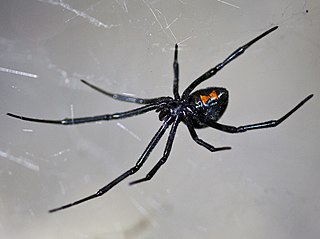
Latrodectus is a broadly distributed genus of spiders with several species that are commonly known as the true widows. This group is composed of those often loosely called black widow spiders, brown widow spiders, and similar spiders. However, such general "common names" are of limited use, as the diversity of species is much greater. A member of the family Theridiidae, this genus contains 34 species, which include several North American "black widows". Besides these, North America also has the red widow Latrodectus bishopi and the brown widow Latrodectus geometricus, which, in addition to North America, has a much wider geographic distribution. Elsewhere, others include the European black widow, the Australian redback black widow and the closely-related New Zealand katipō, several different species in Southern Africa that can be called Button spiders, and the South American black-widow spiders. Species vary widely in size. In most cases, the females are dark-coloured, but some may have lighter or even reddish bodies. Many can have red, white or brown markings on the upper-side (dorsal) of the abdomen. Some can be readily identifiable by reddish markings on the central underside (ventral) abdomen, which are often hourglass-shaped.
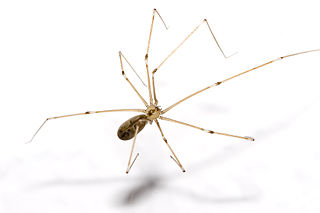
The Pholcidae are a family of araneomorph spiders. The family contains over 1,800 individual species of pholcids, including those commonly known as cellar spider, daddy long-legs spider, carpenter spider, daddy long-legger, vibrating spider, gyrating spider, long daddy, and skull spider. The family, first described by Carl Ludwig Koch in 1850, is divided into 94 genera.
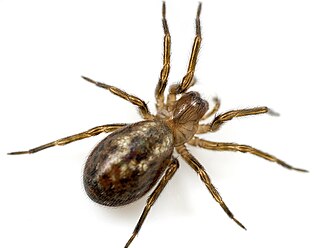
Amaurobius similis is a species of spider in the family Amaurobiidae. It is one of at least two common spiders found in houses known as lace-webbed spiders. The specific name similis is based on its similarity to the species Amaurobius fenestralis. Both are often found near windows, hence the specific name of A. fenestralis.

Oecobius navus is a small cosmopolitan cribellate spider species found across the world.
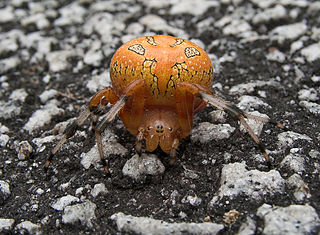
Araneus marmoreus, commonly called the marbled orbweaver, is a species of spider belonging to the family Araneidae. It is sometimes also called the pumpkin spider from the resemblance of the female's inflated abdomen to an orange pumpkin. It has a Holarctic distribution.

Maevia inclemens or the Dimorphic Jumping Spider is a relatively common and colorful jumping spider of North America. In the males there are two forms, a very rare phenomenon in zoology. These use different courting displays, and differ in appearance: the "tufted" morph has a black body and pedipalps ("palps"), three black tufts across its "head", and pale legs; and the "gray" morph has black and white stripes all over its body and legs, orange palps, and no tufts. However, each form accounts for 50% of the adult males, and they are equally successful in mating. A female of Maevia inclemens is 6.5 to 8.0 millimetres long, while males are 4.75 to 6.50 millimetres long.

Pholcus phalangioides, commonly known as daddy long-legs spider or long-bodied cellar spider, is a spider of the family Pholcidae. It is also known as the skull spider, since its cephalothorax resembles a human skull. This is the only spider species described by the Swiss entomologist Johann Kaspar Füssli, who first recorded it in 1775. Its common name of "daddy long-legs" should not be confused with a different arachnid group with the same common name, the harvestman (Opiliones).

Australia has a number of highly venomous spiders, including the Sydney funnel-web spider, its relatives in the family Hexathelidae, and the redback spider, whose bites can be extremely painful and have historically been linked with deaths in medical records. Most Australian spiders do not have venom that is considered to be dangerously toxic. No deaths caused by spider bites in Australia have been substantiated by a coronial inquest since 1979. There are sensationalised news reports regarding Australian spiders that fail to cite evidence. A Field Guide to Spiders of Australia published by CSIRO Publishing in 2017 featuring around 836 species illustrated with photographs of live animals, around 381 genera and 78 families, introduced significant updates to taxonomy from Ramirez, Wheeler and Dmitrov

Argiope pulchella is a species of the orb-weaver spider family, Araneidae. It ranges from India to China and can be found on Java. It is a synanthropic species, often living in habitats associated with humans.

Menemerus bivittatus is a spider in the family Salticidae commonly known as the gray wall jumper. It is a pantropical species and is usually found on the walls of buildings or on tree trunks where it stalks its prey.
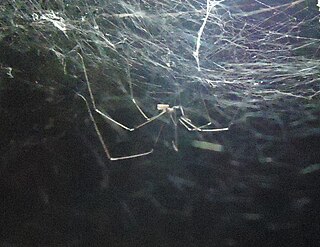
Crossopriza lyoni is a widespread species of cellar spiders that prefer to live in or around human structures. They are commonly known as tailed cellar spiders, tailed daddy longlegs spiders, and sometimes box spiders. They all possess extremely long fragile legs that can reach up to 6 cm (2.4 in) long and a body length of that ranges from 2.5 to 7 mm. Their abdomens are distinctly squarish when viewed from the side and their carapace is more or less circular when viewed from above. They also possess two kinds of sound-producing organs and have six eyes.
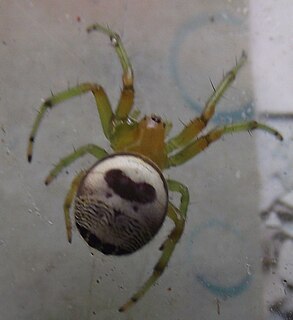
Araneus mitificus, commonly known as the kidney garden spider or pale orb weaver, is a species of orb-weaver spider found in South, East, and Southeast Asia.

Portia schultzi is a species of jumping spider which ranges from South Africa in the south to Kenya in the north, and also is found in West Africa and Madagascar. In this species, which is slightly smaller than some other species of the genus Portia, the bodies of females are 5 to 7 mm long, while those of males are 4 to 6 mm long. The carapaces of both sexes are orange-brown with dark brown mottling, and covered with dark brown and whitish hairs lying over the surface. Males have white tufts on their thoraces and a broad white band above the bases of the legs, and these features are less conspicuous in females. Both sexes have tufts of orange to dark orange above the eyes, which are fringed with pale orange hairs. Males' abdomens are yellow-orange to orange-brown with blackish mottling, and on the upper sides are black and light orange hairs, and nine white tufts. Those of females are pale yellow and have black markings with scattered white and orange-brown hairs on the upper side. P. schultzi has relatively longer legs than other Portia, and a "lolloping" gait.

Progradungula otwayensis, commonly known as the odd-clawed spider, is a species of cribellate spider endemic to the Great Otway National Park of Victoria, Australia. It is one of only two species in the gradungulid genus Progradungula.

Herennia multipuncta, commonly known as the ornamental tree trunk spider, is a species of spider in the family Araneidae native to Asia. It exhibits sexual dimorphism, the female being much larger than the male. It weaves a small web on the trunk of a tree or the wall of a building and is well camouflaged by its dappled colouration.

Holocnemus pluchei, commonly known as the marbled cellar spider, is a species of Pholcidae, a family commonly referred to as "cellar spiders" or "daddy long-legs". This species is distributed across the North Pacific region of the United States, as well as in parts of North Africa, Europe, and the Mediterranean. It is considered a common household spider and builds its nest in attics, basements, and eaves of houses. Although some members of the species live in solitary webs, the majority join already existing webs and migrate to new webs multiple times throughout the course of their lives. A unique feature of H. pluchei is that while in many species of spiders, stridulation commonly occurs by males during sexual encounters, in H. pluchei, females also possess stridulatory organs, and both sexes engage in stridulation.

Avicularia purpurea, also called purple tree tarantula, Ecuadorian purple tarantula or Ecuador purple pinktoe, is a species of spider belonging to the family Theraphosidae (tarantulas).

Heliophanus cupreus, the copper sun jumper, is a species of jumping spider belonging to the family Salticidae.

Neoscona theisi is a species of spider in the family Araneidae. Spiders in the genus Neoscona have a mostly pantropical distribution.

Plexippus petersi is a species of jumping spider native to Asia and has been introduced to Africa and Pacific islands. The male is between 6 and 10 mm in length, and the female is around 10 millimetres (0.4 in). This spider is commonly known as the tropical flycatcher or small zebra jumper.






















